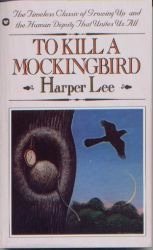Lee, Harper. To Kill a Mockingbird (1960)
rpt. Warner, 1982, 281 pages, $6.99 paperback
ISBN 0-446-31078-6
Highly Recommended

The story takes place in rural Maycomb, Alabama, between the summer of 1933 and Halloween of 1935. In Part One the young narrator, Jean Louise “Scout” Finch, sets the stage for the main action by introducing us to life in her small town, where the farmers have been hit hard by the Depression. We meet Scout’s brother, Jem; her father, lawyer Atticus Finch, whom the children address by his first name; and the family’s black cook, Calpurnia. We also meet Dill, a boy who spends summers with his aunt, the Finches’ next-door neighbor. Scout is almost six years old when the story begins, her brother almost 10.
The novel employs a first-person narrator. This narrator is not the young child telling the story as it happens, but rather an adult remembering events of her childhood. This technique allows the older narrator to present herself whenever necessary to supply information that the child narrator could not have known at the time or to comment on the action.
Scout, Jem, and Dill spend most of their first two summers together devising elaborate schemes to lure their neighbor, Boo Radley, out of his spooky house.
Part Two presents the central action of the novel, the trial of Tom Robinson, in summer, 1935. Bob Ewell, a shiftless and dishonest alcoholic whose family lives in a run-down old shack behind the garbage dump, accuses Tom Robinson, a black man, of raping his daughter Mayella. The town judge has assigned Atticus to defend Tom. Despite Atticus’s upstanding reputation, his neighbors have been hurling offensive remarks about him at his children because of his efforts to defend a black man.
The night before the trial Scout, Jem, and Dill watch Atticus confront a lynch mob in front of the town jail, where Tom Robinson is being held. The cowardly mob disperses when the three children appear and Scout begins talking to one of the men she knows.
After the jury delivers the verdict that everyone knows is a foregone conclusion, Bob Ewell, who feels that Atticus humiliated him on the witness stand, vows to get even. In the story’s dramatic climax, Jem and Scout are attacked on their way home from a Halloween pageant at the school. They are saved by the appearance of a man who carries the unconscious Jem home.
To Kill a Mockingbird is a double coming-of-age story involving both Jem and, to a lesser degree, Scout. In a way the novel is also a coming-of-age story about southern culture as it takes its first small step toward emerging from its racist past.
© 2000 by Mary Daniels Brown
